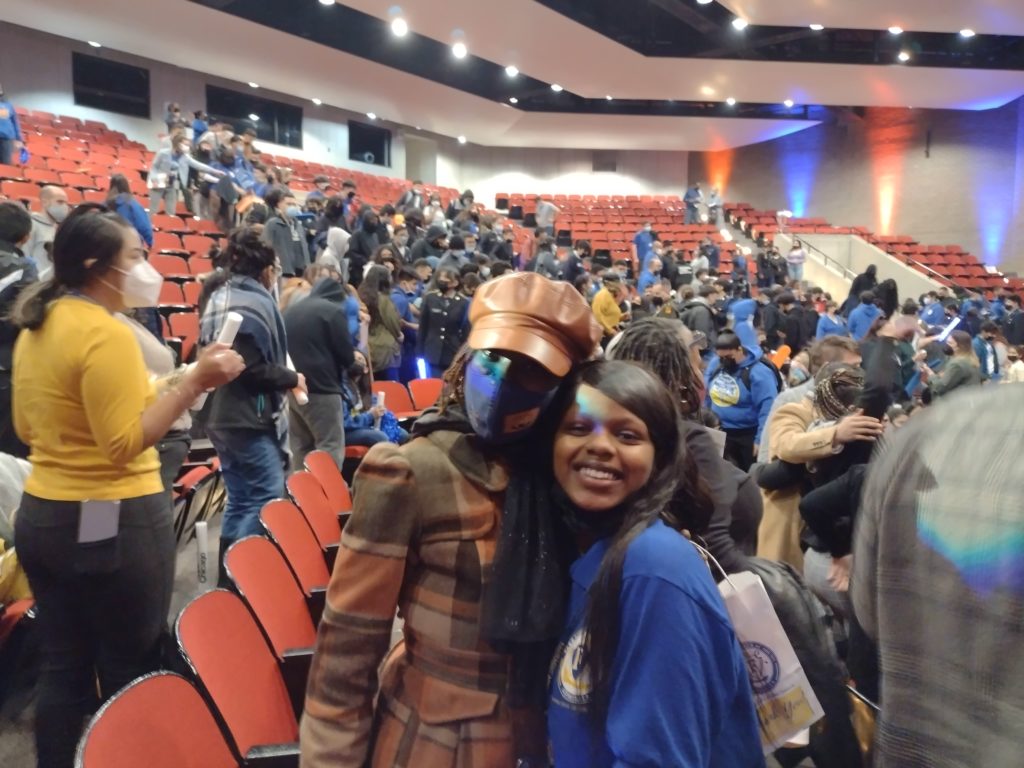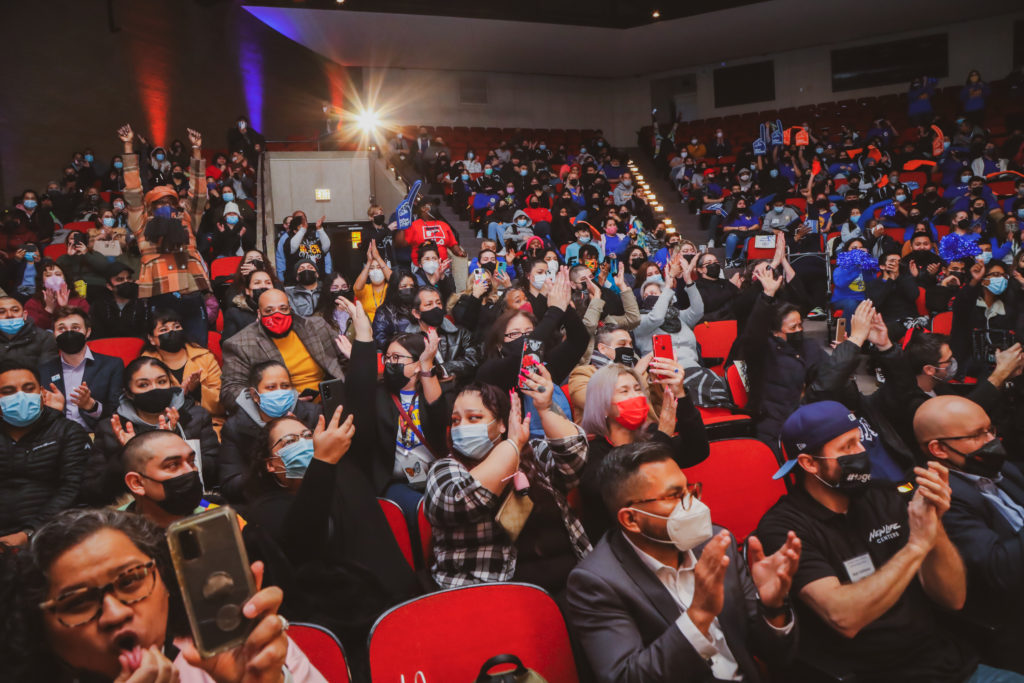Last week, Hope Chicago brought cheers and tears of joy to 4,000 Chicago Public Schools families, with the promise of free college for each current high school student and a family member. But there’s a lot more to the story. The new project takes inspiration from the Kalamazoo Promise and Hope Toledo. Both are “college promise” programs, part of a growing movement to offer low-income young people college money with as few strings attached as possible.
If Hope Chicago reaches its ambitious goals—to raise $1 billion and use the money to support 24,000 Chicago Public Schools graduates and 6,000 of their parents to complete college or trade school—it could push policymakers toward free college for all. Even the initial investment in five high schools could encourage Illinois to make community college free to all. Cost-benefit modeling shows that level of public investment in free college could produce almost $2 for every $1 invested by 2030.
That kind of investment is long overdue in neighborhoods like Little Village/La Villita, home to Farragut High School, one of the five high schools in Hope Chicago’s initial college promise cohort. “This community has been through a lot,” Mayor Lori Lightfoot noted at the assembly announcing Hope Chicago would support all current Farragut students. During the first few months of the pandemic, Little Village was hit hard by COVID. Last April, 13-year-old Adam Toledo was shot by a police officer in the alley behind Farragut’s parking lot. If ever a neighborhood needed an extra boost of hope for young people and their parents, Little Village is it.
But it remains unclear whether Chicago can expect two key spillover benefits that the Kalamazoo Promise has generated: increased enrollment and academic achievement across the entire Kalamazoo Public Schools system, and a small but significant reduction in poverty citywide.
Experts in college access praise Hope Chicago for eliminating a set GPA as a requirement, which ensures the money can get to the students who need it most. “The tried-and-true piece of it is you’re giving money to students for whom it is going to make a difference,” said Michelle Miller-Adams, a senior researcher with the Upjohn Institute who studies the nation’s 204 college promise programs, with a particular focus on Kalamazoo. “It’s a very generous scholarship.”
It will also allow many students to set their sights on higher-quality colleges, more in line with their academic profiles and more likely to get them to the finish line. “We know from research it takes constraints off where you are going to go,” Miller-Adams said. For example, Hope Chicago scholars who previously thought they could only afford community college can now consider 4-year colleges that are likely to have higher completion rates.
But Hope Chicago and its donors want more from their investment. They predict that increasing college access could dramatically increase college completion, which would in turn reduce violence and drive economic growth. They also claim that investing in two generations will build intergenerational wealth in communities of color, and that a college promise in CPS high schools could help draw more families to the system. What will it take to make those predictions come true?

Generous funding may need to get even more generous
Last Friday morning at Farragut High School, 107.5 FM WGCI host Trey White asked seniors, “What’s your passion?”
While others hesitated to announce their dream careers, Starr Owens owned the mic and her vision for her future self: “I want to be an elementary teacher.” When Hope Chicago co-founder and co-chair Pete Kadens broke the news that her college expenses will be paid, she jumped out of her seat and ran across the auditorium theater to hug her mother, Qunia Anderson.
As it turns out, she has already applied to two schools that have officially partnered with Hope Chicago: Illinois State University and Eastern Illinois University. But prior to the announcement, she was not sure she would really have the money to go. “I knew I wanted to go to college to pursue teaching. I didn’t know [enough] about FAFSA. If they didn’t give me enough, how was I going to go college? If I didn’t have the money, most likely I wasn’t going to go.”
Now that she has guaranteed tuition, room, board, books and a laptop at either of two of her choices, she knows she can live on campus and not start at a commuter school. “Now I know it’s a for-sure thing that I’m going to college and I can do what I like, instead of being in a steady working job.”
But making that guarantee stick may well take more than the $750 stipend Hope Chicago promises on top of the directly college-related expenses. Although Hope Chicago has said it will consider additional money for scholars on a case-by-case basis, they could be looking at a lot more money than anticipated.
“We know something about how much unmet need there is: how much kids have to pay to live on top of their college expenses,” said Temple University sociologist Sara Goldrick-Rab, a leading researcher on college affordability and first-generation college students. “Official numbers on college web sites are underestimates. Community college students are facing $8000 a year. I truly believe the real number is $12,000 to $15,000 a year.”
Goldrick-Rab also noted that many first-gen college students use work-study and other employment not only to support themselves, but to help keep their families afloat. Even though Hope Chicago guarantees students at partner higher education programs won’t have to borrow to cover their college costs, meeting their full unmet need could take a lot of money.
Without a Hope Chicago in the picture, students often take on some mix of work and loans to manage these additional expenses. The work may include both work-study and off-campus jobs. “Students who take work-study often end up working two jobs to make ends meet,” said Goldrick-Rab, which can lead to schedule conflicts with classes and working so hard that their grades plummet.
Though most Hope Chicago scholars shouldn’t be taking on debt, Goldrick-Rab suggests that for a handful from families not as deeply impoverished, a small, federally-subsidized loan could be better than taking on too many hours working a low-wage job. “Hopefully they’ll have someone on their team who can think through braiding and blending these funds rather than making a whole bunch of hard and fast rules.”
Nonetheless, Goldrick-Rab remains enthusiastic about Hope Chicago. “Based on what I can tell, this looks really good, and I don’t say that very often. It supports going to college at a time when enrollment is down. It supports people to go when the economy is very unstable.”

More research needed on two-gen college
Owens’ mom, Qunia Anderson, cheered her heart out during the Farragut assembly. But she was cheering more for her daughter than for herself. A single mother of seven children, she will still have one child in high school after Owens graduates in June. “I’m not going to be interested in college right now,” she said.
Hope Chicago’s unique twist on its college promise adds a parent or guardian to the mix. Each eligible family can send a parent or guardian back to school for free alongside their high school graduate(s). “The two-gen thing is fantastic. It tells me they really understand students and families and what it takes to get out of poverty,” said Goldrick-Rab. She cited a new effort in Texas to encourage family and friends to enroll in college together. “Making education a family affair recognizes how close families are. A lot of students who try to go off to college, especially when they are the first, feel horrible about leaving their families. It’s a very savvy move.”
While Miller-Adams agreed that a closer connection between families and college promise programs can help first-gen students stay in school, she took a more skeptical view of parents actually earning degrees. “It’s sometimes highly impractical to the point of impossible” for working parents to start or return to college, Miller-Adams noted. “I don’t know how many takers they’re going to have.”
In 2020, Hope Chicago co-founder Pete Kadens launched his first two-generation college promise program in Toledo, Ohio, with one high school graduating class. Of the 62 high school graduates and their families who are taking part in Hope Toledo (about half of the Jessup High School class of 2021), only about one-fifth, or a dozen, parents immediately took up the offer to return to school. However, all of the parents who chose college persisted through the academic year.

Place-based promises need time to take root
Hope Chicago compares itself to the Kalamazoo Promise, the first college promise program and perhaps the most generous in the nation, covering college tuition and required expenses for all Kalamazoo Public Schools graduates who attend one of these postgraduate programs within 10 years of high school graduation. Thanks to the generosity of three anonymous private donors, the Kalamazoo Promise will be offered to the city’s public high school graduates forever.
However, the Hope Chicago model differs significantly from Kalamazoo Promise. The bottom line: Chicago is a much larger city than Kalamazoo. The Kalamazoo Public Schools enroll 12,000 students, compared to Chicago Public Schools’ 340,000. Between 2005 and 2019, the Kalamazoo Promise paid out $117 million, sending about 7,000 of its high school graduates to 2- and 4-year colleges.
To make a Kalamazoo-level promise—covering full college costs at a group of trade programs, two and four-year schools for every CPS graduate—would take a staggering amount of money, far more than the current $1 billion goal.
Kalamazoo’s college promise has reversed a longstanding trend of declining enrollment in the city’s public schools because it covers all the city’s public schools in perpetuity. By supporting multiple classes of graduates within the same school, and by encouraging parents to pursue high school alongside their children, Hope Chicago expects to transform neighborhoods and stem the tide of declining enrollment in CPS. But it’s not clear whether Hope Chicago can achieve Kalamazoo-style results for CPS and key neighborhoods without making a deeper level of commitment over time to a particular set of schools.
Nonetheless, Hope Chicago’s initial investments, as promised, are in South, West and Southwest side schools—an important stride toward equity. And it has already made promises to more than half as many students as Kalamazoo has actually supported in 15 years.
A question already in play: folks want to know whether more schools can take part. Chicagoans also want to know whether the promise will continue beyond the four current graduating classes at the five initial high schools. This is especially true at Morgan Park, where parents of students in the academic center, which serves seventh- and eighth-graders, want to know if their children will be included.
When I asked Starr Owens if her younger brother, who attends Noble Network’s DRW campus, felt angry for missing out on Hope Chicago’s first round, she answered like a big sister. “He’s not mad,” she said. “I’m mad for him.”
When I asked Monroe Capital’s Ted Koenig, co-chair of Hope Chicago’s board, whether his priority is to extend the Hope Chicago’s college promise for more years at current high schools or bring more on board, he answered: “Expand.”
But researcher Miller-Adams noted that without extending the promise farther in time at participating high schools, Hope Chicago might not achieve its ancillary goals of stopping enrollment decline and helping neighborhoods thrive.
“Hopefully they’re able to do both,’ said Miller-Adams. “The literature would suggest it’s worth making a robust promise so kids in elementary and middle school know they can access it. That would be an argument for extending it in time at the existing schools. If I didn’t have to deal with the political fallout, I would go deeper at the existing schools, but I bet that political fallout is going to be intense.”
Even with all its unknowns, Hope Chicago is bringing the city some much-needed inspiration in the midst of trying times. The effort has energized the local philanthropic community, with $40 million raised in just five months. The latest catch: Walgreens. At Farragut last Friday, Koenig promised to keep pushing. “We’re not gonna rest until we go to every one of these businesses and tell them to invest,” he told the crowd.
Immediately, a student’s voice rang out: “Right on!”
Banner photo credit: Edelman.
Maureen Kelleher
Latest posts by Maureen Kelleher (see all)
- CPS Parents Wanted for Research Study - March 27, 2023
- Tomorrow: Cure Violence with #Belonging - August 17, 2022
- Still Looking for Summer Camp? - June 13, 2022
